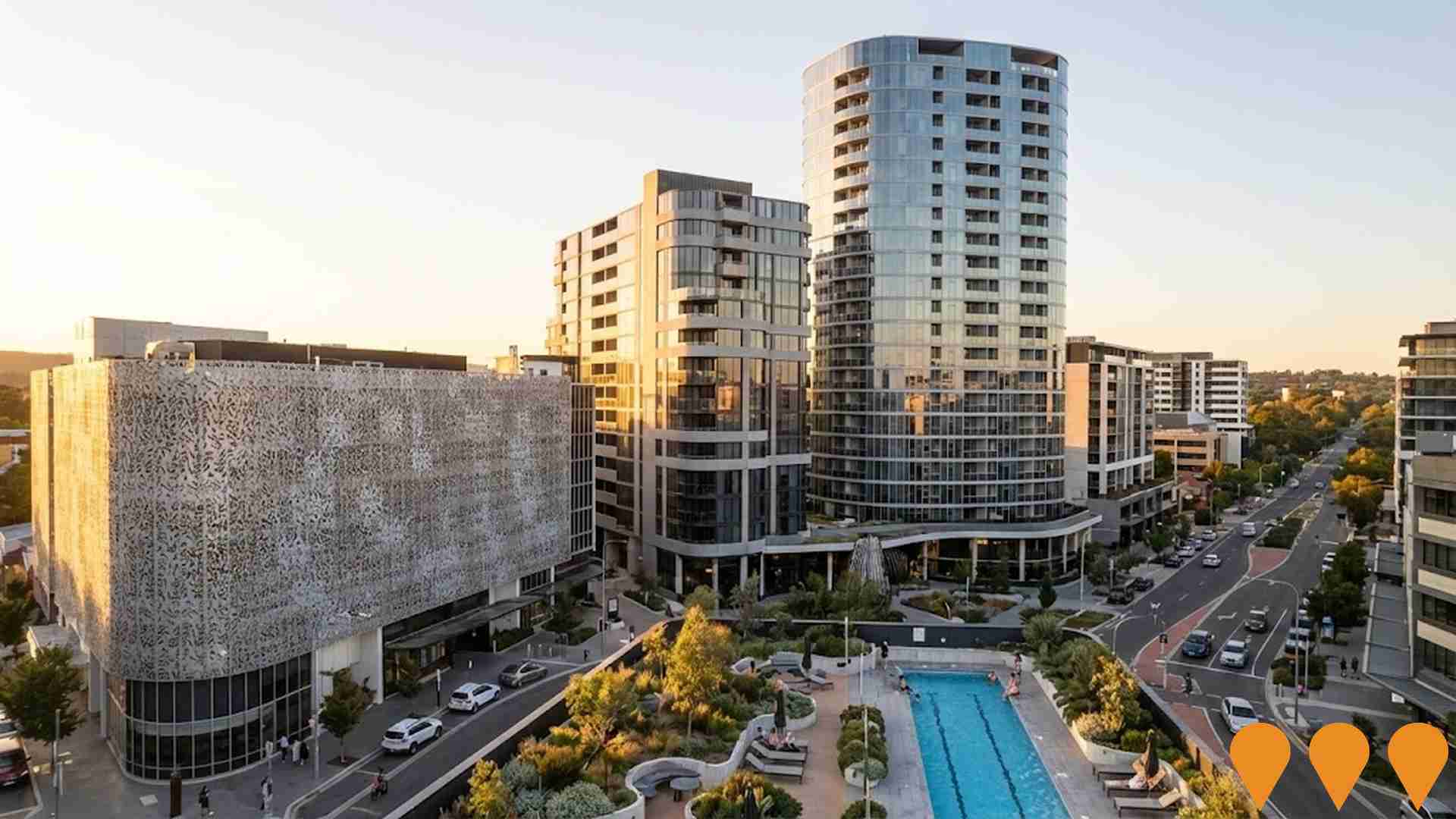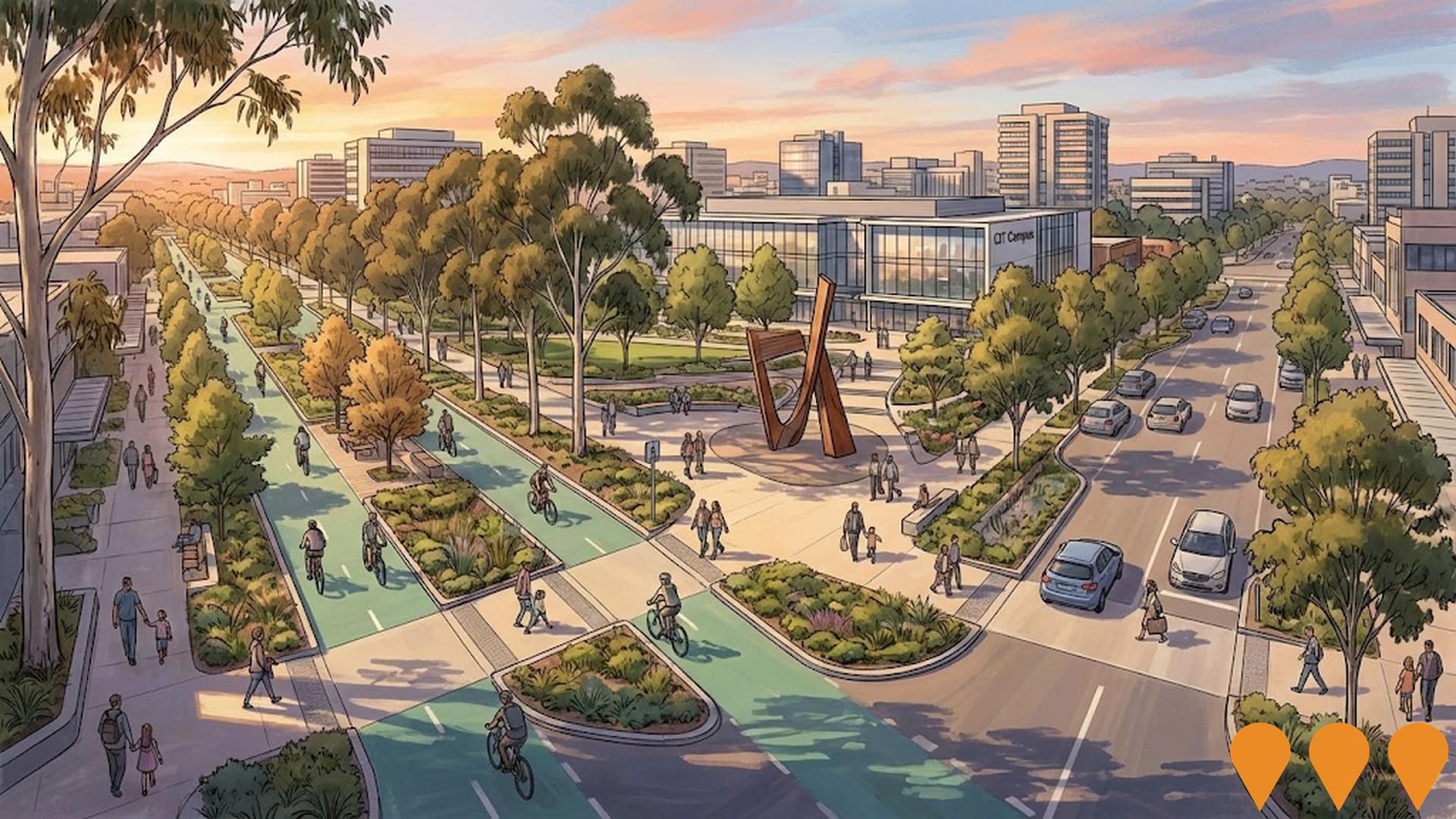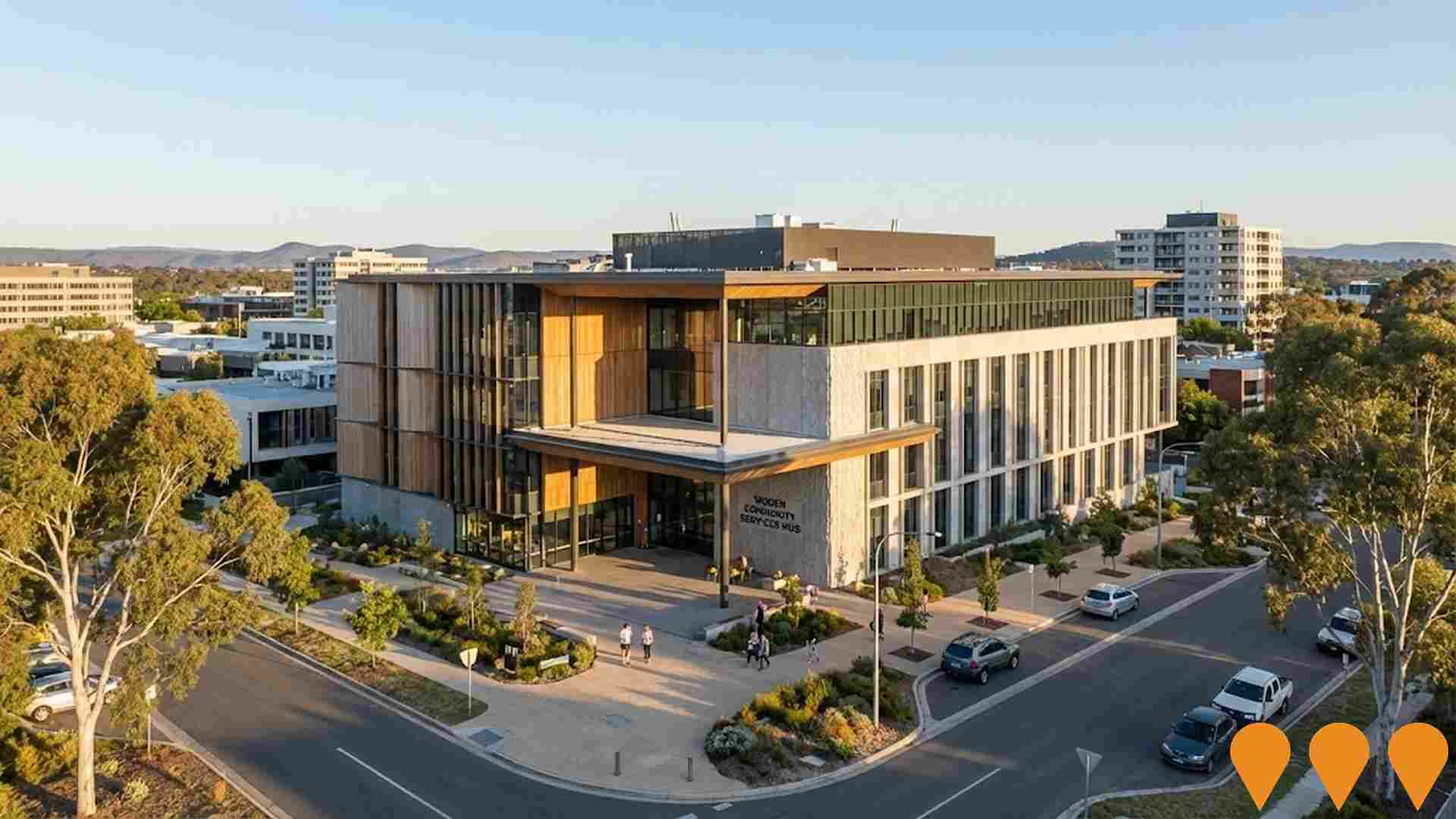Chart Color Schemes
est. as @ -- *
ABS ERP | -- people | --
2021 Census | -- people
Sales Activity
Curious about local property values? Filter the chart to assess the volume and appreciation (including resales) trends and regional comparisons, or scroll to the map below view this information at an individual property level.
Find a Recent Sale
Sales Detail
Population
An assessment of population growth drivers in Chifley reveals an overall ranking slightly below national averages considering recent, and medium term trends
Chifley's population is approximately 2,702 as of August 2025. This figure represents an increase of 22 people since the 2021 Census, which reported a population of 2,680 people. The change is inferred from the estimated resident population of 2,698 in June 2024 and an additional 46 validated new addresses since the Census date. This results in a population density ratio of 1,699 persons per square kilometer, higher than the average across national locations assessed by AreaSearch. Overseas migration contributed approximately 85.7% of overall population gains during recent periods.
AreaSearch uses ABS/Geoscience Australia projections for each SA2 area, released in 2024 with a base year of 2022. For areas not covered and years post-2032, age group growth rates from the ACT Government's SA2 area projections are adopted, also based on 2022. According to these projections, Chifley's population is expected to decline by 144 persons by 2041. However, specific age cohorts like the 85 and over group are projected to increase, with an anticipated growth of 35 people in this cohort.
Frequently Asked Questions - Population
Development
Residential development activity is lower than average in Chifley according to AreaSearch's national comparison of local real estate markets
Chifley averaged approximately 14 new dwelling approvals per year. Between FY21 and FY25, a total of 71 homes were approved, with an additional one approved so far in FY26. Over the past five financial years, there has been an average of 1.7 new residents per year per dwelling constructed.
However, this figure has recently accelerated to 4.5 people per dwelling over the past two financial years, suggesting increasing demand and tightening supply. New properties are constructed at an average expected cost value of $547,000, indicating a focus on the premium market with high-end developments. Compared to the Australian Capital Territory, Chifley has notably lower building activity, recording 67.0% below the regional average per person. This limited new supply generally supports stronger demand and values for established homes.
Recent construction comprises 60.0% detached houses and 40.0% townhouses or apartments, with a growing mix of townhouses and apartments providing options across different price points. The location has approximately 365 people per dwelling approval, reflecting an established area. Given stable or declining population forecasts, Chifley may experience less housing pressure in the future, creating favourable conditions for buyers.
Frequently Asked Questions - Development
Infrastructure
Chifley has moderate levels of nearby infrastructure activity, ranking in the top 50% nationally
Changes to local infrastructure significantly impact an area's performance. AreaSearch has identified 13 projects that may affect this region. Notable ones are Woden Experiment Stage 2 - Public Realm & Active Travel Upgrades, Ivy by Morris (Section 54 Phillip), Woden Town Square Precinct Redevelopment, and Skye by Trilogy (Section 117 Phillip). The following list details those likely to be most relevant.
Professional plan users can use the search below to filter and access additional projects.
INFRASTRUCTURE SEARCH
 Denotes AI-based impression for illustrative purposes only, not to be taken as definitive under any circumstances. Please follow links and conduct other investigations from the project's source for actual imagery. Developers and project owners wishing us to use original imagery please Contact Us and we will do so.
Denotes AI-based impression for illustrative purposes only, not to be taken as definitive under any circumstances. Please follow links and conduct other investigations from the project's source for actual imagery. Developers and project owners wishing us to use original imagery please Contact Us and we will do so.
Frequently Asked Questions - Infrastructure
Canberra Hospital Master Plan
Long-term transformation of Canberra Hospital campus (2021-2041). The new Critical Services Building (Building 5) opened in 2023. Multiple stages are now in construction or detailed planning, including SPIRE Stage 1 (new emergency, surgical and intensive care facilities) and ongoing campus renewal works to deliver modern clinical facilities.

WOVA Residential Precinct
Four distinctive residential towers with 802 apartments, 54 Abode Hotel rooms, and 22 commercial tenancies. Features resort-style amenities including lap pool, fitness studio, private cinema, and rooftop terraces. Completed 2024.

Woden Town Square Precinct Redevelopment
A major mixed-use urban renewal precinct featuring a new public town square, residential apartments, commercial office space, retail, and community facilities as the centrepiece of Woden's revitalisation.

Woden Experiment Stage 2 - Public Realm & Active Travel Upgrades
Major public realm upgrades including new cycling paths, widened footpaths, tree planting, public art and improved connectivity around the new CIT Campus and town centre.

Woden Community Services Hub
A new four-storey facility in Woden Town Centre that will centralise community and government services under one roof, bringing together services currently operating from multiple buildings in the region. It will include child and family services, other community services, meeting rooms, a multi-purpose hall, and workshop spaces to provide efficient support to residents.

Woden Bus Depot and Transport Interchange
The Woden Bus Depot is completed and operational as Australia's largest electric bus depot, capable of housing and charging up to 100 electric buses with modern maintenance facilities. The Woden Transport Interchange is under construction and will be light rail enabled, featuring improved passenger facilities including wide footpaths, enhanced lighting, shelters, bike storage, toilets, and landscaping for better safety and connectivity.

Oaks Arbour Apartments
Modern apartment complex with landscaped courtyards and community facilities. Focus on livability and environmental sustainability.

Ivy by Morris (Section 54 Phillip)
A premium 18-storey residential tower offering 212 apartments with rooftop amenities, ground-floor retail and direct connection to the redeveloped Woden Town Square.

Employment
Employment conditions in Chifley demonstrate strong performance, ranking among the top 35% of areas assessed nationally
Chifley has a highly educated workforce with essential services sectors well represented. Its unemployment rate was 2.9% in the past year.
Employment growth was estimated at 2.8%. As of June 2025, 1,565 residents were in work, with an unemployment rate of 3.4%, 0.6% below the Australian Capital Territory's rate. Workforce participation was broadly similar to the ACT's 69.6%.
Leading employment industries among residents comprised public administration & safety, health care & social assistance, and professional & technical services. However, education & training was under-represented at 7.3%, compared to the ACT's 9.6%. The predominantly residential area appeared to offer limited local employment opportunities, as indicated by Census data. Between June 2024 and June 2025, employment levels increased by 2.8% while labour force grew by 1.6%, resulting in a 1.2 percentage point drop in unemployment. In comparison, the ACT recorded employment growth of 1.9%, labour force growth of 1.6%, with unemployment falling by 0.3 percentage points. Jobs and Skills Australia's national employment forecasts from May 2025 projected national employment expansion at 6.6% over five years and 13.7% over ten years, with varying growth rates between industry sectors. Applying these projections to Chifley's employment mix suggested local growth of approximately 6.6%% over five years and 13.5% over ten years.
Frequently Asked Questions - Employment
Income
Income metrics indicate excellent economic conditions, with the area achieving higher performance than 75% of national locations assessed by AreaSearch
Chifley's median income among taxpayers was $64,273 in financial year 2022. The average income stood at $80,270 during the same period. These figures compare to those for the Australian Capital Territory of $68,678 and $83,634 respectively. By September 2025, estimates based on a 13.6% growth in wages since financial year 2022 suggest median income will be approximately $73,014 and average income around $91,187. Census data shows household, family, and personal incomes all rank highly in Chifley, between the 86th and 90th percentiles nationally. Income distribution reveals that 30.8% of residents (832 people) fall within the $1,500 - $2,999 bracket, reflecting a pattern seen more broadly where 34.3% occupy this range. A substantial proportion of high earners, at 38.1%, indicates strong economic capacity in the suburb. Housing accounts for 14.5% of income, with residents ranking within the 86th percentile for disposable income. The area's SEIFA income ranking places it in the 9th decile.
Frequently Asked Questions - Income
Housing
Chifley displays a diverse mix of dwelling types, with a higher proportion of rental properties than the broader region
At the latest Census, dwelling structures in Chifley comprised 67.7% houses and 32.3% other dwellings (semi-detached, apartments, 'other' dwellings), compared to Australian Capital Territory's 67.7% houses and 41.7% other dwellings. Home ownership levels in Chifley were at 32.3%, similar to the Australian Capital Territory average, with mortgaged dwellings at 35.2% and rented dwellings at 32.4%. The median monthly mortgage repayment in Chifley was $2,383, higher than the Australian Capital Territory average of $2,167. Median weekly rent in Chifley was recorded at $450, compared to the Australian Capital Territory figure of $440. Nationally, Chifley's median monthly mortgage repayments were significantly higher than the Australian average of $1,863, while median weekly rents were substantially above the national figure of $375.
Frequently Asked Questions - Housing
Household Composition
Chifley features high concentrations of group households and lone person households, with a fairly typical median household size
Family households account for 64.2% of all households, including 28.1% couples with children, 25.6% couples without children, and 8.7% single parent families. Non-family households constitute the remaining 35.8%, with lone person households at 30.7% and group households comprising 4.7% of the total. The median household size is 2.4 people, which aligns with the Australian Capital Territory average.
Frequently Asked Questions - Households
Local Schools & Education
The educational profile of Chifley exceeds national averages, with above-average qualification levels and academic performance metrics
Chifley's educational attainment is notably higher than national averages. Among residents aged 15+, 52.2% hold university qualifications, compared to Australia's 30.4% and the SA4 region's 46.8%. Bachelor degrees are most common at 29.5%, followed by postgraduate qualifications (16.5%) and graduate diplomas (6.2%). Vocational pathways account for 22.9% of qualifications, with advanced diplomas at 10.8% and certificates at 12.1%.
Educational participation is high, with 28.9% of residents currently enrolled in formal education. This includes 8.1% in primary, 7.9% in tertiary, and 5.9% in secondary education. Educational facilities seem to lie outside immediate catchment boundaries, necessitating families to access schools in neighboring areas.
Frequently Asked Questions - Education
Schools Detail
Nearby Services & Amenities
Transport
Transport servicing is low compared to other areas nationally based on assessment of service frequency, route connectivity and accessibility
Chifley has ten active public transport stops, all bus services. Two routes operate here, offering a total of 171 weekly passenger trips. Residents enjoy good transport accessibility, with an average distance of 223 meters to the nearest stop.
Services run approximately 24 times daily across both routes, translating to about 17 weekly trips per individual stop.
Frequently Asked Questions - Transport
Transport Stops Detail
Health
The level of general health in Chifley is notably higher than the national average with prevalence of common health conditions quite low across both younger and older age cohorts
Chifley demonstrates low prevalence of common health conditions across both younger and older age cohorts. Private health cover rate is high at approximately 60% of the total population (1,615 people), compared to 68.1% across Australian Capital Territory.
The most common medical conditions are mental health issues affecting 8.6% of residents and arthritis impacting 7.6%. 70.7% of residents declare themselves completely clear of medical ailments, compared to 70.1% across Australian Capital Territory. 16.0% of residents are aged 65 and over (430 people), lower than the 18.3% in Australian Capital Territory. Health outcomes among seniors are above average, broadly in line with the general population's health profile.
Frequently Asked Questions - Health
Cultural Diversity
Chifley was found to be more culturally diverse than the vast majority of local markets in Australia, upon assessment of a range of language and cultural background related metrics
Chifley, surveyed in June 2016, had a population with 30.9% born overseas and 26.5% speaking languages other than English at home. Christianity was the predominant religion at 40.0%. Hinduism was overrepresented compared to the Australian Capital Territory average of 6.6%, comprising 8.1% of Chifley's population.
The top three ancestry groups were English (23.6%), Australian (20.8%), and Other (14.3%). Spanish, Serbian, and Croatian ethnicities showed notable overrepresentation in Chifley compared to regional averages: Spanish at 0.8% vs 0.5%, Serbian at 0.7% vs 0.4%, and Croatian at 0.9% vs 0.8%.
Frequently Asked Questions - Diversity
Age
Chifley's population is slightly younger than the national pattern
Chifley's median age is 37 years, slightly older than the Australian Capital Territory's 35 but aligned with the national average of 38 years. The 35-44 age group constitutes 16.8%, higher than the Australian Capital Territory figure, while the 15-24 cohort makes up 11.3%. Between 2021 and the present, the 35-44 age group has increased from 15.2% to 16.8% of the population. Conversely, the 45-54 age group has decreased from 12.3% to 10.9%. By 2041, Chifley's demographic is projected to change significantly. The 85+ age cohort is expected to increase by 23 people (39%) from 60 to 84 years old. Notably, the combined 65+ age groups will account for 91% of total population growth, indicating an aging demographic profile in the area. In contrast, both the 0-4 and 15-24 age groups are projected to decrease in numbers.




